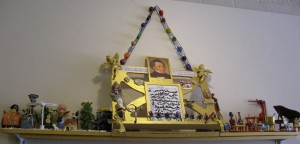Schubert is my favourite composer. This is the only homage I’ve made to a musician because I don’t think it’s possible to translate music into visual art. However, Schubert has been my soul mate since I first heard him at the age of about five, and I couldn’t have left him out. I listen almost exclusively to his music when I am making art and he has taught me most of what I know about composition, colour, variation, and emotional tone. I saw the frame (it is actually a book-rest) in Faversham market and immediately knew who it was for. The first and hardest thing to sort out with any of these pieces is the basic structure. Sometimes I think about it for months, other times something on a stall jumps out at me and the whole inspiration comes from that (see also Chekhov).
On the main music stand I have tried to show Schubert’s love of classical music and art (the music itself, bust of Beethoven, cherubs) and his interest in and use of folk and street music (marching band, dancers), his sense of humour and sensitivity to sound ( his ‘cat’ MS), and his Austrian heritage (alpine souvenirs). The lefthand extension is about his two great song-cycles, “Winterreise” at the front, and “Die Schöne Müllerin” at the back. The upright piano between them is to show the more intimate and homely settings in which Schubert’s works were originally performed. The right-hand extension shows at the back the instruments of a string quartet, an extra cello for his string quintet in C Major and a grand piano for the trout quintet (see also trout in a basket) and for his great piano sonatas and impromptus. The front represents the evenings with his friends, either in coffee houses, or at the Schubertiads where many of his works were first performed. The smallest chair is there because of his extremely short stature. (I wanted him to be comfortable.)
The most difficult problem with all of these pieces is trying to find some way of representing an abstract quality, especially if it is more important than anything more illustrable (such as the beautiful Miller’s daughter). On the necklace, the different coloured beads represent major keys interspersed with minor keys, reflecting Schubert’s mastery of modulation, which gives his music its characteristics of wit, emotional depth and subtlety.
And all the gold … well, he’s the tops.
